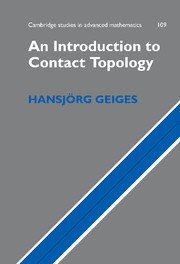Book contents
- Frontmatter
- Contents
- Preface
- 1 Facets of contact geometry
- 2 Contact manifolds
- 3 Knots in contact 3—manifolds
- 4 Contact structures on 3—manifolds
- 5 Symplectic fillings and convexity
- 6 Contact surgery
- 7 Further constructions of contact manifolds
- 8 Contact structures on 5—manifolds
- Appendix A The generalised Poincaré lemma
- Appendix B Time-dependent vector fields
- References
- Notation index
- Author index
- Subject index
Preface
Published online by Cambridge University Press: 05 November 2009
- Frontmatter
- Contents
- Preface
- 1 Facets of contact geometry
- 2 Contact manifolds
- 3 Knots in contact 3—manifolds
- 4 Contact structures on 3—manifolds
- 5 Symplectic fillings and convexity
- 6 Contact surgery
- 7 Further constructions of contact manifolds
- 8 Contact structures on 5—manifolds
- Appendix A The generalised Poincaré lemma
- Appendix B Time-dependent vector fields
- References
- Notation index
- Author index
- Subject index
Summary
‘We are all familiar with the after-the-fact tone ― weary, self-justificatory, aggrieved, apologetic ― shared by ship's captains appearing before boards of inquiry to explain how they came to run their vessels aground and by authors composing Forewords.’
John Lanchester, The Debt to PleasureContact geometry, as a subject in its own right, was born in 1896 in the monumental work of Sophus Lie on Berührungstransformationen (contact transformations). Lie traces the pedigree of contact geometric notions back to the work of Christiaan Huygens on geometric optics in the Traité de la Lumière of 1690 ― or even Apollonius of Perga's Conica from the third century BC ― and to practically all the famous mathematicians of the eighteenth and nineteenth century.
But as late as 1990, when I began my journey into contact geometry, the field still seemed rather arcane. To the prescience of Charles Thomas I owe the privilege of starting graduate work in an area that was only just beginning to flourish. This, of course, had its drawbacks ― there were no texts from which to learn the essentials. Even contact geometry's elder sibling, symplectic geometry ― firmly established as the natural language for classical mechanics, and brought into prominence by Gromov's influential 1985 paper on pseudoholomorphic curves ― suffered from a similar dearth.
- Type
- Chapter
- Information
- An Introduction to Contact Topology , pp. x - xviPublisher: Cambridge University PressPrint publication year: 2008

